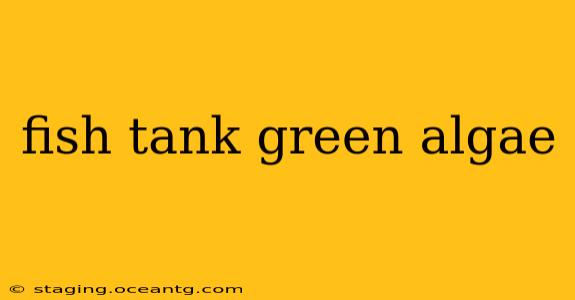Green algae in your fish tank can be a frustrating sight, transforming your once-pristine aquarium into a murky, green swamp. But don't despair! Understanding the causes and implementing effective solutions can restore your tank's clarity and the health of its inhabitants. This comprehensive guide will equip you with the knowledge and strategies to combat green algae and maintain a thriving aquatic ecosystem.
What Causes Green Algae in Fish Tanks?
Green algae thrive in environments with specific conditions. Understanding these factors is crucial for prevention and treatment. The most common culprits are:
- Excess Light: Too much light, either in duration or intensity, fuels algae growth. This is often the primary cause.
- Nutrient Overload: High levels of nitrates and phosphates, stemming from overfeeding, decaying organic matter, or insufficient filtration, provide ample nutrients for algae to flourish.
- Insufficient Water Changes: Regular water changes are essential for removing excess nutrients and waste products that feed algae growth.
- Poor Filtration: An inadequate or poorly maintained filter fails to remove essential nutrients and waste contributing to algae blooms.
How to Get Rid of Green Algae in a Fish Tank?
Tackling green algae requires a multi-pronged approach focusing on addressing the underlying causes and implementing effective removal strategies.
- Reduce Lighting: Decrease the duration of your tank's lighting cycle. Start by reducing it by a couple of hours daily.
- Improve Filtration: Ensure your filter is adequately sized for your tank and that the filter media is regularly cleaned or replaced as needed. Consider upgrading to a more powerful filter if necessary.
- Regular Water Changes: Perform regular partial water changes (25-50% of the tank volume) weekly to remove excess nutrients and waste.
- Manual Removal: For smaller infestations, gently scrub the algae off surfaces using a dedicated algae scraper or a soft sponge. Be sure to remove any debris immediately.
- Control Fish Population: Overstocking can lead to nutrient buildup, so ensure your tank isn't overcrowded.
- Algae Eaters: Some fish species, like Siamese Algae Eaters, help control algae growth. However, they are not a replacement for proper tank maintenance.
What are Different Types of Green Algae?
There are several types of green algae that can appear in aquariums. Identifying the type can help tailor your approach:
- Free-Floating Green Algae (Green Water): This type is suspended in the water column and makes the water appear cloudy green. Addressing nutrient issues and light levels is key.
- Hair Algae: This appears as thin, wispy strands that attach to surfaces. Manual removal and addressing nutrient imbalances are important.
- Spot Algae: This appears as small, green spots on surfaces. Regular cleaning and reducing light intensity often resolve this.
How Often Should I Clean My Fish Tank to Prevent Algae?
Regular maintenance is crucial for algae prevention. A good routine includes:
- Weekly Water Changes: 25-50% water changes weekly are recommended.
- Monthly Filter Cleaning: Clean or replace filter media as per manufacturer instructions.
- Regular Substrate Cleaning: Siphon the substrate to remove debris and waste.
- Glass Cleaning: Regularly clean the glass to remove algae before it becomes a large problem.
What are the Best Algae Cleaners for Fish Tanks?
Various products claim to control algae. However, focusing on proper tank maintenance is far more effective than relying solely on chemicals. Overuse of chemicals can harm your fish and disrupt the tank's ecosystem.
Can I Use Bleach to Clean My Fish Tank?
No, never use bleach to clean your fish tank. Bleach is highly toxic to fish and other aquatic life. Use aquarium-safe cleaners and always rinse thoroughly before refilling the tank.
How Do I Prevent Green Algae in My Fish Tank?
Prevention is always better than cure. By implementing these practices, you can significantly reduce the chances of green algae appearing:
- Proper Lighting: Use appropriate lighting intensity and duration for your tank's inhabitants and plant life.
- Balanced Diet: Avoid overfeeding your fish. Remove uneaten food promptly.
- Regular Maintenance: Adhere to a consistent cleaning and water change schedule.
- Proper Filtration: Ensure your filter is sufficient for your tank size and is maintained regularly.
By following these guidelines, you can create a healthy and thriving aquarium environment free from the nuisance of green algae. Remember, a proactive approach to maintenance is the best defense against unsightly and potentially harmful algae blooms.
